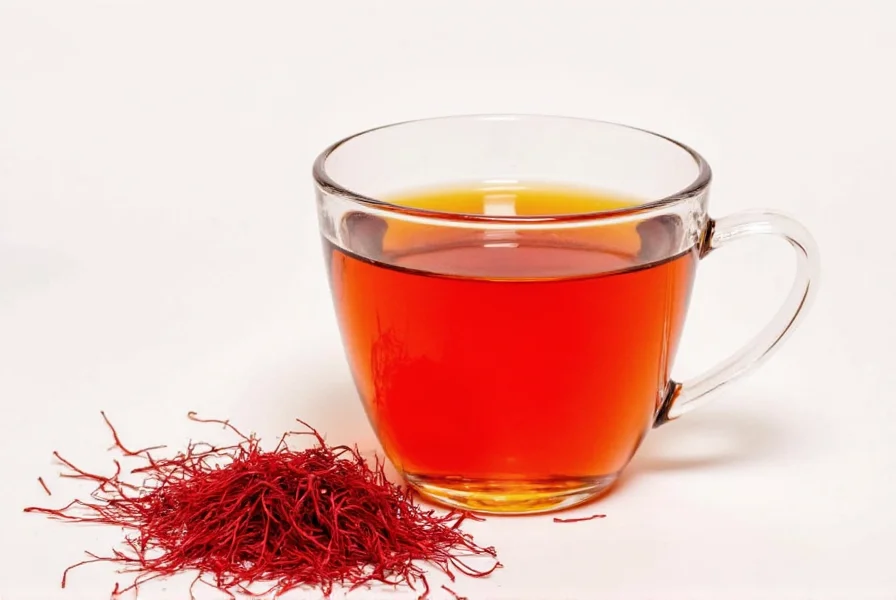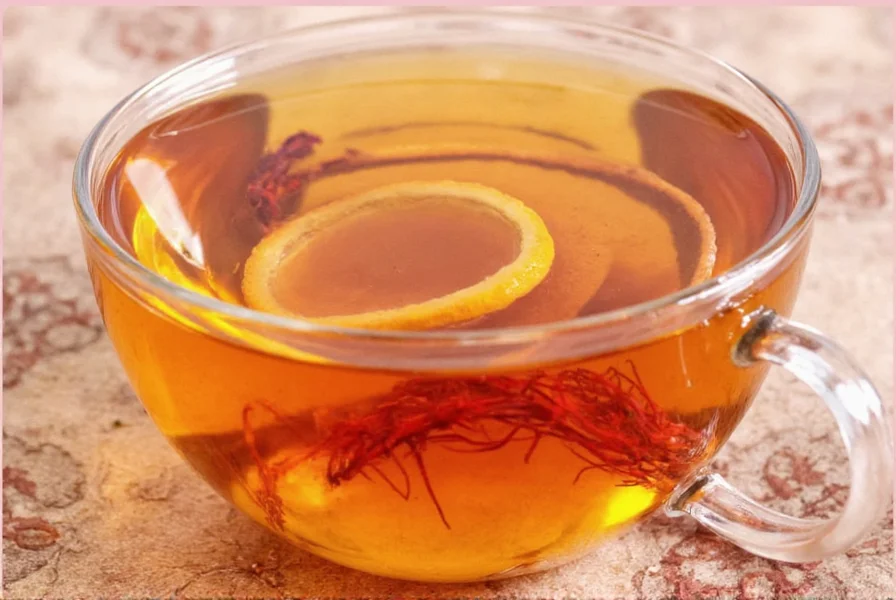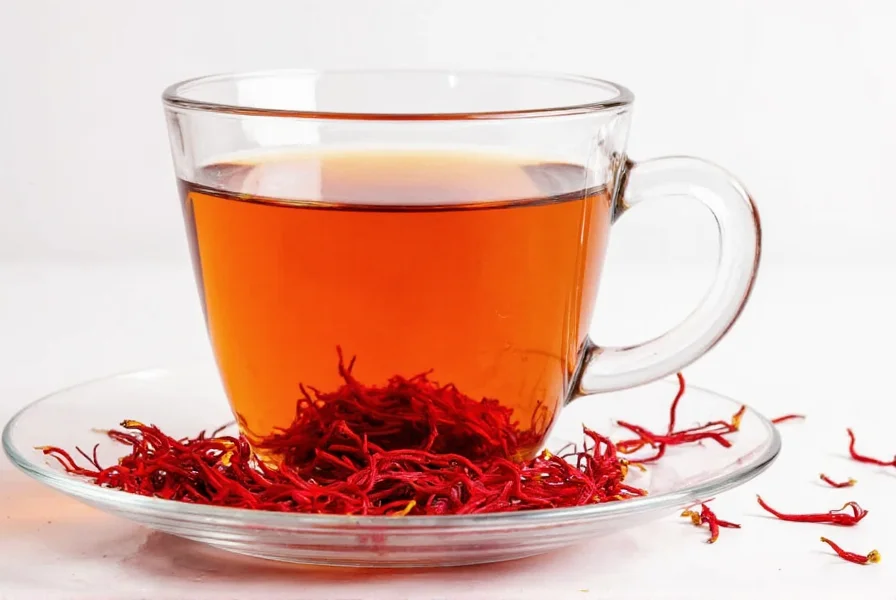Saffron tea has captivated cultures for millennia, prized not only for its vibrant color but also for its unique sensory profile and potential wellness properties. This delicate infusion represents one of the world's most expensive spices transformed into a soothing beverage that's gaining attention in modern wellness circles.
What Exactly Is Saffron Tea?
Saffron tea differs fundamentally from conventional teas. While black, green, and oolong teas come from the Camellia sinensis plant, saffron tea is an herbal tisane created exclusively from the hand-harvested stigmas of the Crocus sativus flower. Each purple crocus bloom produces just three red stigmas, which are carefully picked and dried to create the precious saffron threads. This labor-intensive process explains saffron's status as the world's most expensive spice by weight.
When preparing authentic saffron tea, only pure saffron threads contact water—no additional tea leaves or herbs. Some commercial products misleadingly market "saffron tea" blends containing tea leaves with minimal saffron, which doesn't deliver the genuine experience or potential benefits of pure saffron infusion.
Historical Journey of Saffron Infusions
Historical records show saffron's use in ancient Persian, Egyptian, and Greek cultures, where it appeared in medicinal preparations and ceremonial beverages. Traditional Persian medicine incorporated saffron into wellness regimens for mood support and digestive health. In medieval Europe, apothecaries prescribed saffron infusions for various ailments. This rich heritage continues today, with saffron tea remaining integral to Middle Eastern and South Asian wellness traditions.

Proper Preparation Technique for Optimal Flavor
Creating authentic saffron tea requires precision to maximize flavor and potential benefits:
- Measure carefully: Use 15-30 threads (0.1-0.2g) per cup—excessive amounts create bitterness
- Activate threads: Gently crush threads between fingers before steeping to release compounds
- Water temperature: Use water just below boiling (85-90°C / 185-195°F)—boiling water degrades delicate compounds
- Steeping time: Allow 5-15 minutes depending on desired strength
- Optional enhancements: A squeeze of lemon may increase solubility of active compounds
Unlike many herbal teas, saffron tea produces a luminous golden-yellow hue rather than deep red or brown. The flavor profile features subtle floral notes with hints of honey and earthiness—never overpowering when properly prepared.
Evidence-Based Health Considerations
Research suggests saffron contains bioactive compounds like crocin, crocetin, and safranal that may offer several wellness benefits. Multiple clinical studies, including randomized controlled trials published in Nutritional Neuroscience and Human Psychopharmacology, indicate potential mood-supporting properties comparable to certain conventional approaches for mild mood concerns.
Additional research areas include:
| Research Area | Current Evidence Level | Key Findings |
|---|---|---|
| Mood Support | Strongest evidence | Multiple RCTs show benefits for mild mood concerns at 30mg daily doses |
| Antioxidant Activity | Well-documented | High ORAC value; protects cells from oxidative stress |
| Sleep Quality | Preliminary | Early studies suggest potential sleep-supporting effects |
| Appetite Regulation | Emerging | Some evidence for supporting healthy eating patterns |
It's crucial to note that while research is promising, saffron tea shouldn't replace medical treatment. The concentration of active compounds in a typical cup remains significantly lower than doses used in clinical studies. Most research uses standardized extracts rather than tea preparations.
Sensory Experience and Flavor Profile
Saffron tea offers a distinctive sensory experience unlike any other beverage. The aroma features delicate floral notes with subtle earthy undertones. When properly prepared, the taste balances subtle sweetness with mild bitterness—never overwhelming. The visual appeal of the luminous golden infusion adds to the experience, creating what many describe as a "sunshine in a cup" sensation.
Connoisseurs distinguish premium saffron tea by:
- Bright golden-yellow color (darker red indicates lower quality)
- Complex aroma without mustiness
- Smooth finish without excessive bitterness
- Persistent flavor that lingers pleasantly

Selecting Quality Saffron for Tea
Given saffron's high value, adulteration is common. When selecting saffron for tea preparation:
- Look for deep red threads with minimal yellow style (the white part)
- Verify origin—premium saffron comes from Iran, Kashmir, or Spain
- Check for ISO 3632 certification indicating quality standards
- Avoid powders which are frequently adulterated
- Perform the water test: genuine saffron slowly releases golden color
A small investment in quality saffron yields significantly better tea. A single gram (about 400 threads) can make 20-30 cups of tea when used properly. Store saffron in an airtight container away from light to preserve potency.
Safety Guidelines and Considerations
Saffron tea is generally safe when consumed in culinary amounts. However, important considerations include:
- Dosage: Limit to 1-2 cups daily (equivalent to 15-60 threads)
- Pregnancy: Avoid therapeutic doses during pregnancy
- Medication interactions: May interact with antidepressants and blood thinners
- Quality concerns: Adulterated saffron may contain harmful substitutes
- Allergic reactions: Rare but possible, especially in those allergic to crocus plants
The European Medicines Agency considers doses up to 1.5g daily safe for short-term use, but culinary preparations like tea typically contain far less. If you have health conditions or take medications, consult your healthcare provider before regular consumption.
Authentic Saffron Tea Experience
For those seeking the genuine saffron tea experience, understanding traditional preparation methods enhances appreciation. In Persian culture, saffron tea often accompanies social gatherings, served in delicate glass cups to showcase its golden hue. The slow preparation process—crushing threads, carefully controlling water temperature, and allowing proper steeping time—becomes a mindful ritual that contributes to the overall experience.
Unlike commercial herbal blends labeled as "saffron tea," authentic preparation uses only pure saffron threads and water. This purity allows appreciation of saffron's subtle complexity without competing flavors. The resulting beverage serves as both a sensory delight and potential wellness support when enjoyed as part of a balanced lifestyle.
Frequently Asked Questions
How much saffron should I use for one cup of tea?
For a single cup of saffron tea, use 15-30 threads (approximately 0.1-0.2 grams). This amount provides optimal flavor without bitterness. Remember that saffron's potency means a little goes a long way—using more than 50 threads per cup typically creates an unpleasantly bitter taste.
Can saffron tea help with anxiety and stress?
Emerging research suggests saffron may support emotional wellness. Several clinical studies indicate that saffron compounds might help maintain healthy stress responses and emotional balance. However, the concentration in tea is lower than therapeutic doses used in studies. Saffron tea shouldn't replace professional treatment for anxiety disorders but may complement wellness routines when consumed as part of a balanced lifestyle.
How does saffron tea taste compared to other herbal teas?
Saffron tea offers a unique flavor profile distinct from common herbal teas. It features delicate floral notes with subtle honey-like sweetness and mild earthiness, without the grassiness of green tea or the robustness of black tea. The taste is nuanced and sophisticated—never overpowering when properly prepared. Unlike many herbal teas, it produces a luminous golden color rather than brown or red hues.
Is saffron tea safe to drink daily?
Yes, saffron tea is generally safe for daily consumption in culinary amounts (1-2 cups containing 15-60 threads total). However, therapeutic doses used in clinical studies (30mg saffron extract daily) exceed what's typically consumed in tea form. Those with medical conditions, pregnant women, or individuals taking medications should consult healthcare providers before regular consumption.
How can I tell if my saffron tea is made from genuine saffron?
Authentic saffron tea shows specific characteristics: threads should be deep red with minimal yellow style, the infusion should produce a luminous golden-yellow color (not orange or red), and the aroma should be floral and delicate. When steeped, genuine saffron slowly releases color over 5-15 minutes. Powdered "saffron" is frequently adulterated—always use whole threads from reputable sources with proper certification.











 浙公网安备
33010002000092号
浙公网安备
33010002000092号 浙B2-20120091-4
浙B2-20120091-4